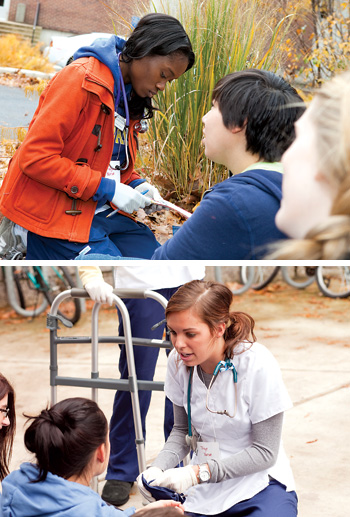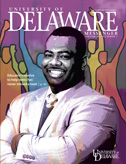Prospective nurses learn the drill for disaster

ON THE GREEN | The distraught young woman is sobbing. "Don't help me, help my baby," she cries. "Please tell me now—is he going to die?"
She drops to her knees as a nurse gently takes the infant from her and carries him toward the makeshift morgue on the grass. "Where are you taking my baby?" she screams. "No, bring him back. I need my baby."
The disaster scene is chillingly realistic, with healthcare professionals rushing to help the injured, people screaming in pain and fear and a triage area set up on the outskirts of the site. But it's not real; it's a simulation on the UD campus.
The School of Nursing holds such drills twice a year to prepare students for large-scale disasters with mass casualties. Fall semester's scenario was a sports arena roof collapse. Past episodes have included a school shooting and an explosion in a campus student center.
"This is not about giving CPR," Prof. Bethany Hall-Long says. "This is about mass casualty and all hazards preparation to teach our students how to coordinate efforts and triage people from one system to the next."
To help make the drills even more realistic, nursing faculty began to consult with UD's internationally renowned Disaster Research Center (DRC) last year. This year, graduate students from the School of Public Policy and Administration's Disaster Science and Management Program observed the exercise to provide constructive feedback to the drill participants.
"Our students are primarily involved in the communication and coordination aspects of a disaster like this," says Jim Kendra, DRC director and associate professor of public policy and administration. "They're looking at how the medical professionals communicate with each other and how they distribute information."
The nursing students quickly learn that handling a disaster is about much more than assessing and treating physical injuries. The young mother whose infant has died is relentless—she alternates between begging the nurses to help the baby and accusing them of placing other victims' needs over hers.
"These are important lessons for our students," says Amy Cowperthwait, resource simulation center coordinator in the School of Nursing, "and a drill like this can help them develop the skills they need to deal appropriately with people who are frantically trying to get help and find lost loved ones."
She says some prospective nursing students have expressed an interest in attending UD because of the opportunity to take part in such disaster drills.
The value of the drills was also brought home to Cowperthwait when she received a recent email from a student.
"I just wanted to tell you how much the disaster drill you put together last semester helped me this summer," the student wrote. "I worked in the ER of Bellevue Hospital in NYC, and when our disaster phone rang the day the steam pipe exploded, it was a complete panic. I really felt prepared because of the drill, and I was able to understand what was going on…. I was thrown in a hazmat suit, and I helped shower the people covered in asbestos. The way the ER ran that day was very similar to the drill we ran last spring."
Article by Diane Kukich , AS73, 84M






